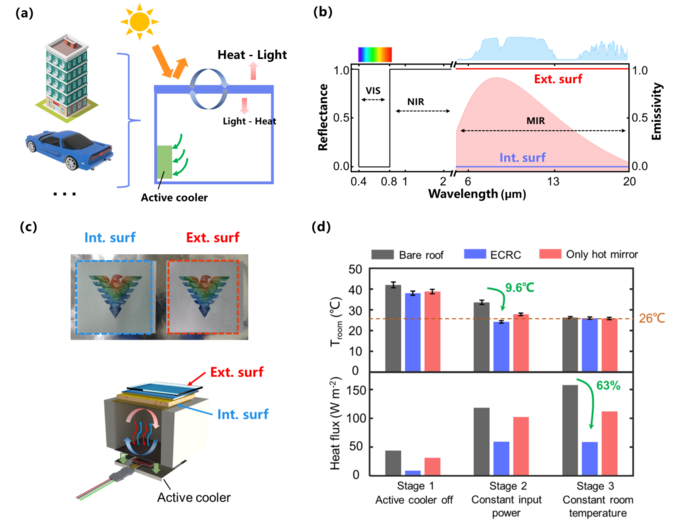Reviewed by Alex SmithMay 9 2022
The entire international community agrees that the main global challenges in the contemporary decades will be attaining a carbon emission peak and eventually becoming carbon neutral. According to research, building energy consumption accounts for more than 35% of overall energy consumption, with HVAC (heating, ventilation, and air conditioning) systems accounting for 44%.
 a Schematic diagram of the heat exchange between an actively temperature regulated enclosure and external space via the roof. b Ideal spectra for the exterior surface (red) and the interior surface (blue) of ECRC (Enhanced color-preserving radiative cooling) system. c Upper: optical image of the patterns covered by the two surfaces. Lower: simulated enclosure with the device. d Experimental results: comparing room temperature and energy consumption among bare roof, roof with only hot mirror and roof with ECRC. Image Credit: Yining Zhu, Hao Luo, Chenying Yang, Bing Qin, Pintu Ghosh, Sandeep Kaur, Weidong Shen, Min Qiu, Pavel Belov, and Qiang Li
a Schematic diagram of the heat exchange between an actively temperature regulated enclosure and external space via the roof. b Ideal spectra for the exterior surface (red) and the interior surface (blue) of ECRC (Enhanced color-preserving radiative cooling) system. c Upper: optical image of the patterns covered by the two surfaces. Lower: simulated enclosure with the device. d Experimental results: comparing room temperature and energy consumption among bare roof, roof with only hot mirror and roof with ECRC. Image Credit: Yining Zhu, Hao Luo, Chenying Yang, Bing Qin, Pintu Ghosh, Sandeep Kaur, Weidong Shen, Min Qiu, Pavel Belov, and Qiang Li
Radiative cooling has recently received a lot of attention as a passive cooling method that can efficiently reduce the target temperature by increasing the thermal emissivity and solar reflectivity of the object surface; however, its integration with the current actively regulated temperature and decorative enclosures has slipped out of the research at the moment.
A team of scientists led by Professor Qiang Li from Zhejiang University and Professor Min Qiu from Westlake University in China has proposed a photonic-engineered thermal management strategy that incorporates an enhanced color-preserving radiative cooling (ECRC) system into the existing actively temperature-regulated and decorative enclosure. This new paper was published in Light Science & Application. Energy consumption can be reduced by up to 63% with smart energy regulation.
The improved color-preserving radiative cooling system is based on a heat transfer model that includes enclosures, active coolers and the environment (atmosphere, outer space, and sun).
Taking into account a variety of parameters, the authors recommend that the exterior surface of the structure should both reflect solar energy and emit infrared energy, while the interior surface should prevent heat radiation from entering the inner space. Furthermore, the coated films should be highly translucent to blend in with the existing structures.
Researchers used SiO2/TiO2 stack film as the outside surface and ITO-PET film as the internal surface to design and build the device. Photonic optimization improves spectral performance to near-optimal levels. The device’s cooling performance and energy-saving impact are next tested using a simulated enclosure.
Under the same conditions, the findings demonstrate that the indoor temperature of the enclosure with the device is 9.6 °C lower than that of the enclosure without the device.
When the interior temperature is set to around 26 °C, the energy consumption of the enclosure with the device is lowered by 63% when compared to that without the device, demonstrating the gadget’s amazing energy-saving capacity.
Moreover, due to the device’s general great transparency in the visible band, hardly any color change may be seen when covering ornamental surfaces with the device. As a result, the gadget may be attached to existing roofs or windows without losing aesthetics.
Journal Reference:
Zhu. Y., et al., (2022) Color-preserving passive radiative cooling for an actively temperature-regulated enclosure Light Science & Applications 10.1038/s41377-022-00810-y